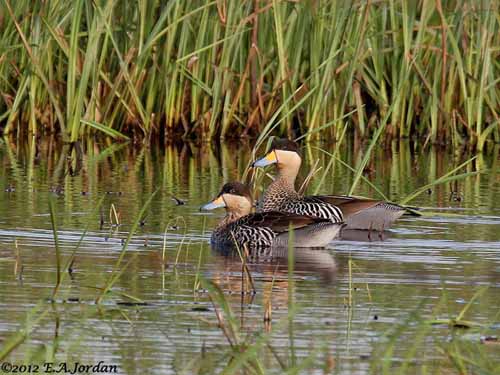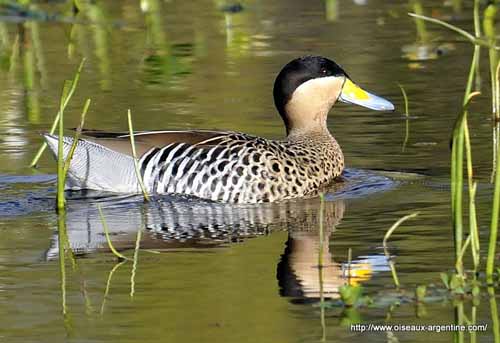
Fr: Sarcelle bariolée
All: Silberente
Esp: Cerceta Argentina, Cerceta Capuchina, Pato capuchino, Pato capuchino austral
Ita: Anatra versicolore
Nd: Zilvertaling
Sd: Silverand
Port: Marreca-cricri
Photographers:
John Anderson
John Anderson Photo Galleries
Eduardo Andrés Jordan
MIS AVES – AVES DE ARGENTINA
Otto Plantema
Trips around the world
Philippe et Aline Wolfer
OISEAUX D'ARGENTINE
Text by Nicole Bouglouan
Sources:
HANDBOOK OF THE BIRDS OF THE WORLD vol 1 by Josep del Hoyo-Andrew Elliot-Jordi Sargatal - Lynx Edicions - ISBN: 8487334105
GUIDE DES CANARDS, DES OIES ET DES CYGNES – de Steve Madge - Delachaux et Niestlé - ISBN: 2603013769
BirdLife International (BirdLife International)
Silver Teal
Anas versicolor
Anseriformes Order – Anatidae Family
INTRODUCTION:
The Silver Teal is now separated from the Puna Teal (Anas puna) which is a full species. Two subspecies are recognized and share the wide range in S South America and the Falklands where the local name is Pampa Teal.
DESCRIPTION OF THE BIRD:
Biometrics:
Length: 38-43 cm
Weight: 440-470 g
The adult of nominate race has blackish mantle, back and scapulars with yellowish-white edges to feathers. On the upperwings, tertials are dark brown with yellowish edges. The upperwing-coverts are grey, with broad white terminal band to greater coverts. The secondaries are glossy green with narrow, black subterminal band and broad white border. This pattern forms the speculum. Short tail, rump and uppertail-coverts show dark grey and white vermiculations.

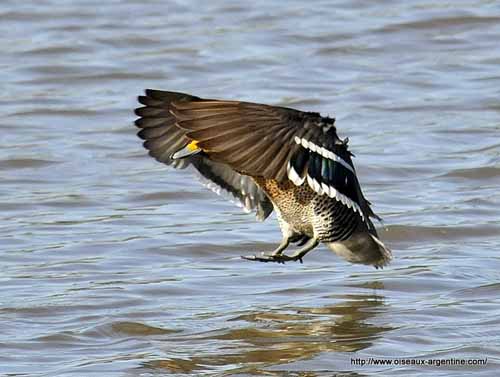
On the underparts, breast, upper belly and fore flanks are yellowish with blackish-brown spots, whereas the rear flanks are densely barred. Lower belly, vent and undertail-coverts show dark grey and white vermiculations. The underwing is white, with grey flight feathers and dark leading edge.
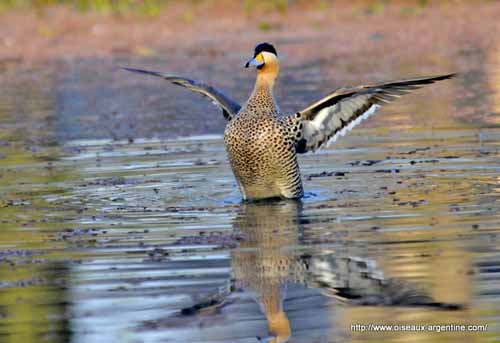
On the head, crown and nape are brownish-black. Cheeks and neck are pale buffy-white.
The broad bill is pale blue with pale yellow upper base and black culmen and nail. The eyes are dark brown. Legs and webbed feet are dark grey.
The female is duller, with less distinct barred flanks, shorter tertials and duller bill, sometimes without yellow at base. She is slightly smaller than male.
The juvenile resembles adults but it is duller, with browner head, less distinct pattern, more streaked than mottled plumage, and duller speculum.
SUBSPECIES AND RANGE:
A.v. versicolor (here described) occurs from S Bolivia to extreme S Brazil, and S to NO Argentina.
A.v. fretensis is found from C Chile and C Argentina, S to Tierra del Fuego and Falkland Islands.
This one is slightly larger than nominate. Flanks show broader black bands. The plumage is darker, with browner pattern.
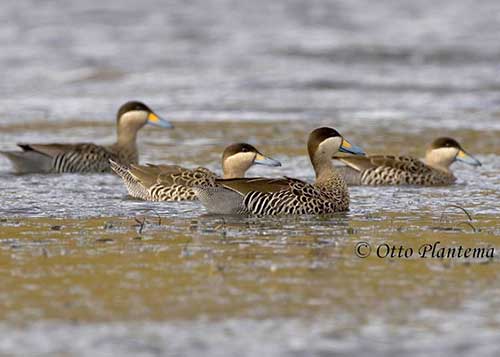
A.v. fretensis
Falkland Islands
HABITAT:
The Silver Teal frequents a variety of freshwater wetland types such as lakes, swamps and ponds with well-established aquatic vegetation.
In South America, it occurs from pampas marshes to puna areas in the Andes, up to 4600 metres of elevation.
In the Falklands, it can be seen on ponds with aquatic vegetation.
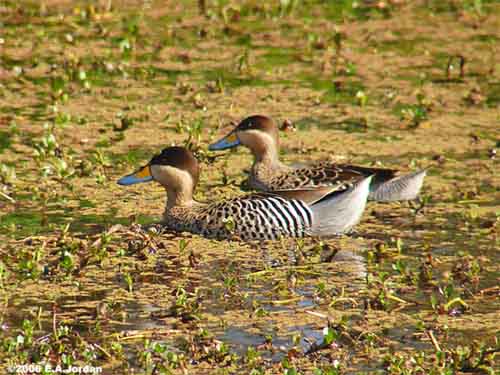
CALLS AND SONGS: SOUNDS BY XENO-CANTO
The Silver Teal is usually fairly silent. However, some sounds often accompany the behaviour. The male produces a continuous rattle while swimming. When they are in family groups with parents and chicks, the male gives a series of quiet buzzing sounds as alarm calls.
The female produces loud quacking notes before breeding, and a long decrescendo call including more than ten notes.
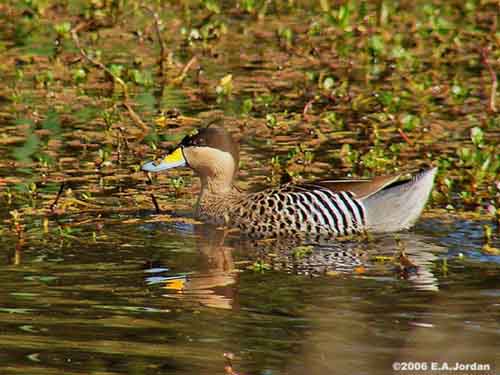
BEHAVIOUR IN THE WILD:
The Silver Teal feeds on seeds and tender parts of aquatic plants. It also takes aquatic invertebrates such as insects and their larvae, molluscs and crustaceans. In the Falklands, the diet includes pond weed and various aquatic invertebrates.
The Silver Teal forages by dabbling, head-dipping and upending in shallow water, and also by walking along the lake shores. It rarely dives.
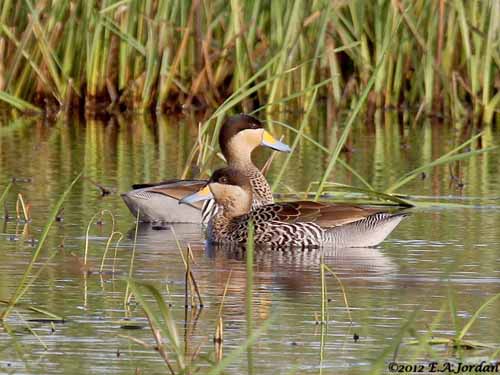
The Silver Teal usually occurs in pairs or small family groups, and can be seen among other Anatidae species.
The pairs may have long-term pair-bonds, and both mates usually remain together all year round. However, males could be polygamous and are seen sometimes pursuing other females for extra-pair copulation.
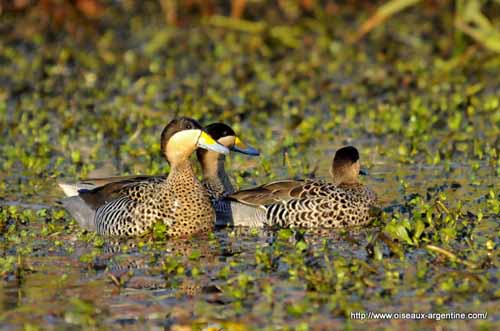
This species is a partial migrant, but it is resident in the Falklands. Populations of extreme South of the range usually move northwards during winter. They can reach SE Brazil. The birds which breed at high elevation may perform altitudinal movements and reach the lowlands.
The Silver Teal performs fast and powerful flight. If disturbed, it flies away low and rapidly and finally returns to the same place.
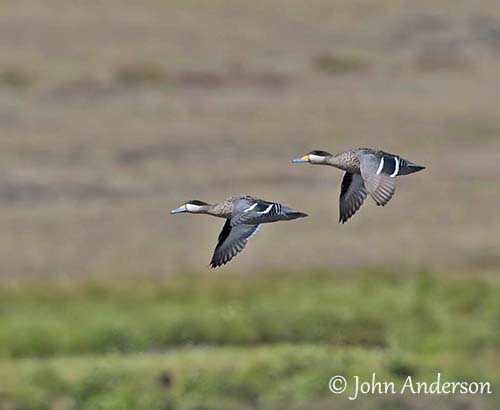
A.v. fretensis
Falkland Islands
REPRODUCTION OF THIS SPECIES:
The breeding season occurs between September and January in S South America, and the laying occurs between October and December in the Falklands.
The Silver Teal may nest in isolated pairs or in loose groups. The nest is on the ground among the vegetation.
In the Falklands, it is hidden in the dense vegetation and near water.
The female builds the nest in the grass, and the depression is lined with down.
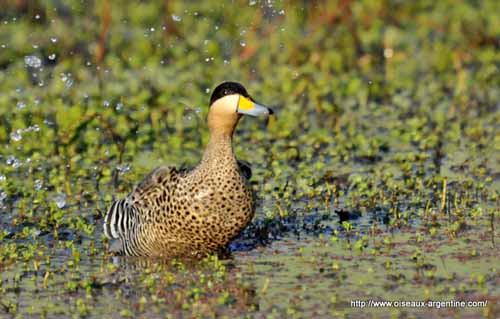
She lays 6-10 ochraceous eggs and incubates alone during about 25-26 days. At hatching, the chicks are dark brown above and pale greyish below, with white dorsal spots on wings and sides. They have a broad black eye stripe extending to the nape. The bill is greyish-blue.
They leave the nest very soon after hatching, and are able to feed themselves. Both parents care and protect them.
In the Falklands, most chicks have fledged by February.
This species produces a single brood per season.
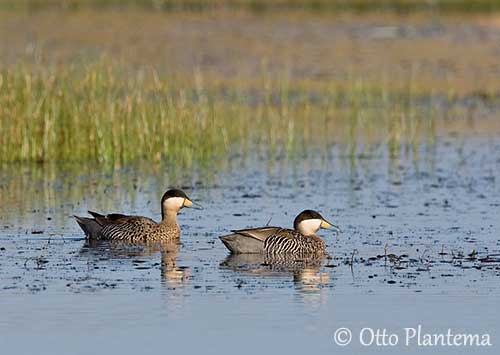
A.v. fretensis
Falkland Islands
PROTECTION / THREATS / STATUS:
The Silver Teal is relatively widespread and locally abundant. The population is estimated at 25,000/100,000 individuals for the two subspecies.
In the Falklands, there are about 1,000 breeding pairs (1983-1993).
This species is not currently threatened, and evaluated as Least Concern.
